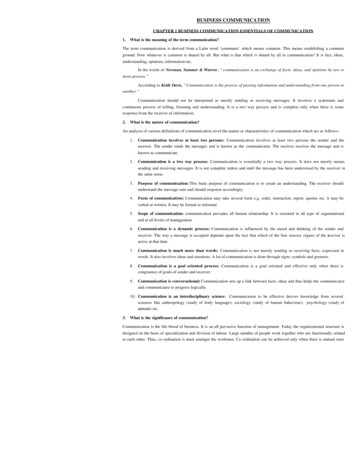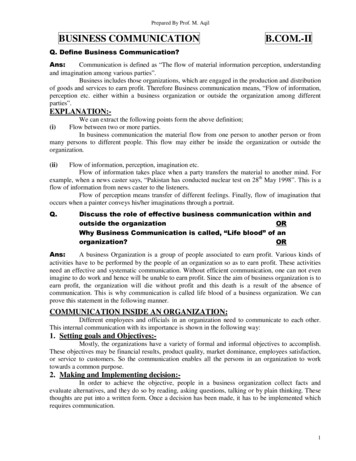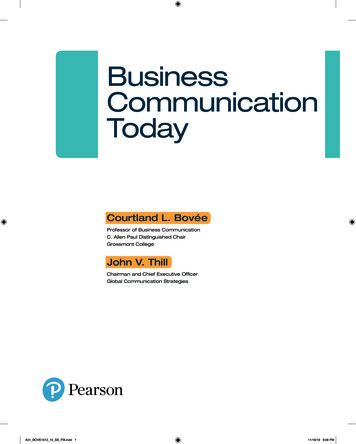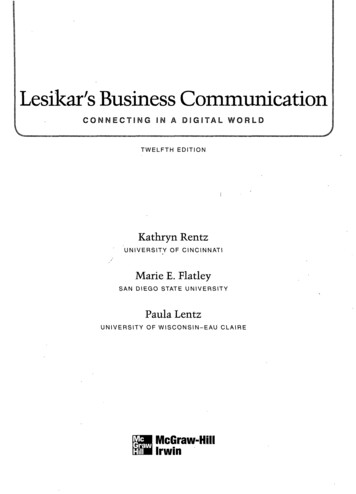
Transcription
BUSINESS COMMUNICATIONCHAPTER 1 BUSINESS COMMUNICATION ESSENTIALS OF COMMUNICATION1. What is the meaning of the term communication?The term communication is derived from a Latin word ‘communis’ which means common. This means establishing a commonground. Now whatever is common is shared by all. But what is that which is shared by all in communication? It is fact, ideas,understanding, opinions, information etc.In the words of Newman, Summer & Warren , “ communication is an exchange of facts, ideas, and opinions by two ormore persons.”According to Keith Davis, “ Communication is the process of passing information and understanding from one person toanother.”Communication should not be interpreted as merely sending or receiving messages. It involves a systematic andcontinuous process of telling, listening and understanding. It is a two way process and is complete only when there is someresponse from the receiver of information.2. What is the nature of communication?An analysis of various definitions of communication revel the nature or characteristics of communication which are as follows:1.Communication involves at least two persons: Communication involves at least two persons the sender and thereceiver. The sender sends the messages and is known as the communicator. The receiver receives the message and isknown as communicate.2.Communication is a two way process: Communication is essentially a two way process. It does not merely meanssending and receiving messages. It is not complete unless and until the message has been understood by the receiver inthe same sense.3.Purpose of communication: This basic purpose of communication is to create an understanding. The receiver shouldunderstand the message sent and should response accordingly.4.Form of communication: Communication may take several form e.g. order, instruction, report, queries etc. it may beverbal or written. It may be formal or informal.5.Scope of communication: communication pervades all human relationship. It is essential in all type of organizationaland at all levels of management.6.Communication is a dynamic process: Communication is influenced by the mood and thinking of the sender andreceiver. The way a message is accepted depends upon the fact that which of the fine sensory organs of the receiver isactive at that time.7.Communication is much more than words: Communication is not merely sending or receiving facts, expressed inwords. It also involves ideas and emotions. A lot of communication is done through signs, symbols and gestures.8.Communication is a goal oriented process: Communication is a goal oriented and effective only when there iscongruence of goals of sender and receiver.9.Communication is conversational: Communication sets up a link between facts, ideas and thus helps the communicatorand communicatee to progress logically.10. Communication is an interdisciplinary science: Communication to be effective derives knowledge from severalsciences like anthropology (study of body language), sociology (study of human bahaviour), psychology (study ofattitude) etc.3. What is the significance of communication?Communication is the life blood of business. It is an all pervasive function of management. Today the organizational structure isdesigned on the basis of specialization and division of labour. Large number of people work together who are functionally relatedto each other. Thus, co ordination is must amongst the workmen. Co -ordination can be achieved only when there is mutual trust
and understanding between them. This understanding is cre ated by effective communication. Thus communication is an essentialingredient for effective management. Further the role of communication may be summed up as: 1.The objectives, plans and policies of the organization are cleared to the workers through commu nication.2.It provides unity of direction to various activities of the enterprise.3.It helps in controlling and coordinating the various activities of the organization.4.It helps in motivating the workers of an organization.5.It helps the managers to develop t heir managerial skill.4. What is the need of communication?According to Sir John Harvey-Jones, “Communication is the single most essential skill. Effective communication is the needof the day.” In resent times communication has become all more essential du e to the following reasons:1.Growth in the size of the business organization: An efficient system of communication is required because thebusiness organizations are growing tremendously. Thousands of people work in the organization. Organizations havefactories or offices in different parts of the country or even world.2.Advance technology: Day by day rapid changes are taking place in science and technology leading to obsolescence ofold technology. Thus in order to upgrade or modernize technology proper co mmunication between the superior andsubordinate in an organization is a must.3.Tough competition in the market: Globalization and liberalization have resulted in cut throat co mpetition. Thus tosurvive such competition, persuasive communication in form of advertisement, publicity, personal contacts are essential.4.Growing specialization: Division of work paved way for specialists to work in different department’s soundcommunication is thus essential for ensuring mutual cooperation and understanding between different departments.5.Trade union movement: trade union movement is on its growth. Management now has to consult trade unions onvarious matters. A strong and meaningful relation between management and trade union is possible only by effectivecommunication.6.Human relation: Employee’s participation in management helps to develop among them a sense of loyalty andbelongingness towards the organization. Thus effective communication between management and employee is necessaryto develop mutual trust and confidence.7.Public relations: Public relations help an organization to improve its image in society as the organization has a socialresponsibility especially towards the customers.5. What is the process of Communication?The process of communication is the inter relationship between several independent components. It consists of a chain ofrelated actions and reaction which together result in exchange of information. In order to understand the process ofcommunication, it is necessary to describe each of these components.A model of communication process is as follows: -(ii) IDEATION(iii) INCODING(iv) TRANSMISSION(i) SENDER(ix)FEEDBACK(v) RECEIVER(viii) BEHAVIOUROFRECIEVER(vii)DECODING(vi) RECEIVING
1. Sender: The sender is the first component of the process of c communication. The sender may be a speaker, a writer orany other person. He is the one who has a message and wants it to share it for some purpose.2. Ideation: Ideation is the preliminary step in communication where sender creates an idea to communicate. This idea isthe content and basis of the message to be communicated. Several ideas may generate in the sender’s mind. The sendermust identify, analyze and arrange the ideas sequentially before transmitting them to the receiver.3. Message: Message is the heart of communication. It is what the sender wants to convey to the receiver. It may be verbali.e. written or spoken or non verbal i.e. body language, space language, etc.4. Encoding: To encode is to put an idea into words. In this step the communicator organizes his ideas into a series ofsymbols or words which will be communicated to the intended receiver. Thus the ideas are converted into words orsymbols. The words and the symbols should be selected carefully, it should be understandable and most of all it shouldbe suitable for transmission and reception.5. Transmission: Next in the process of communication is transmission of the message as encoded messages aretransmitted through various media and channels of communication connects the sender and the receiver. The channel andmedia should be selected keeping in mind the requirement of the receiver, the communication to be effective andefficient the channel should be appropriate.6. Receiver: Receiver is the person or group for whom the message is meant. He may be a listener, a reader or a viewer.Any neglect on the part of the receiver may make the communication inef fective. Receiver is thus the ultimatedestination of the message. It the message does not reach the receiver the communication is said to be incomplete.7. Decoding: Decoding means translation of symbols encoded by the sender into ideas for understanding. Understandingthe message by receiver is the key to the decoding process. The message should be accurately reproduced in thereceiver’s mind. If the receiver is unable to understand the message correctly the communication is ineffective.8. Behaviour of the rec eiver: It refers to the response by the receiver of the communication received from the sender. Hemay like to ignore the message or to store the information received or to perform the task assigned by the sender. Thuscommunication is complete as soon as the receiver responses.9. Feedback: Feedback indicates the result of communication. It is the key element in the communication and is the onlyway of judging the effectiveness of communication. It enables the sender to know whether his message has been prope rlyinterpreted or not. Systematic use of feedback helps to improve future message. Feedback, like the message could beoral, written or non verbal. It has to be collected from the receiver.6. What is the channel of communication?A channel means a path or a way. Thus a channel of communication is the path or way through which information istransmitted throughout the organization. It is the route through which the message flows from the sender to the receiver.7. What are the different channels of communication in an organization?H u man beings in an organization are inter related to each other. They are related both formally as well as informally. Theserelationships are maintained by means of communication. Therefore there exists in an organization two channel s ofcommunication: 1.Formal channel of communication2.Informal channel of communication8. What is implied by Formal Channel of communication?A formal channel of communication is the officially prescribed route for the flow of communication. It is that route ofcommunication which is institutionally determined and is associated with status or position of the receiver and sender. Theformal channels are deliberately related to ensure that accurate information flows smoothly and timely.
9. What are the various forms of Formal channel of communication?Human beings in an organization are inter related to each other. They are related both formally as well as informally. Theserelationships are maintained by means of communication. Therefore there exists in an org anization two channels ofcommunication:1.Formal channel of communication2.Informal channel of communicationBoard of DirectorsManaging countsPublic RelationDownward communication: Communication that flows from the top level of the organization to the bottom level alongwith the scalar chain is known as downward communication. Example for such type of communication are orders,instructions, rules, policies, programs and directives etc. it specifies the extent of the subordinates authority and theirresponsibility.2.Upward Communication: Upward communication is just the opposite of downward communication. In thiscommunication system, the message is transmitted from the bottom of the organization upward to the top of theorganization through the middle managers along with the line. Usually this includes workers grievances, suggestions andreactions. This communication system was not appreciated by the superiors. But it has assured importance in moderntimes and is considered to be a main source of motivating employees.3.Horizontal communication: The flow of information between departments or people of equal level in an organizationalstructure may be termed as horizontal or lateral communication. The two departments may be under the same superior ormay have different heads. Such communication may be written or oral. The main object of lateral communication is toco-ordinate the efforts of different departments or persons.4.Diagonal communication: Diagonal communication is between people who are neither in the same department nor onthe same level of organizational structure. It cuts across departmental lines. It generally takes place when memberscannot communicate effectively through other channels.These upward, downward, horizontal or diagonal communication may be oral, written, i nformal or gestural.10. What are the advantages of Formal Channel of communication?1.All information flows through the proper channel in an orderly and smooth way.2.Formal channel helps in fixing responsibilities for the activities carried out in an organization thereby ensuring control.3.In Formal Channel the superior and the subordinates are in direct contact with each other. So a better understandingdevelops between them.4.The information is filtered at every level of organization which ensures that only essen tial & necessary informationpassed to the next level.5.Formal channel cover all sub system of an organization.
11. What are the disadvantages of Formal communication?1.Formal channel is a slow and rigid channel therefore they are time consuming.2.The superiors are overloaded as they have to filter the information and pass only the essential part of information.3.Formal channel is a narrow channel of communication.4.Possibilities of over filtration of information cannot be denied which may lead to distortions of in formation.5.Formal channel are expensive as the messages are generally conveyed in writing.12. What is the implied by Informal communication?The informal channel of communication is that channel of communication which is not officially prescribed. It is that routewhich is used by workmen in an organization to maintain social (informal) relationship amongst themselves. It is thus createdas a result of operation of social force in an organization. It can be said that informal communication flows through corridorsto water coolers, down hallways through lunchrooms and where ever workmen get together in groups.Informal communication co -exists along with formal communication and supplements it.13. What is a Grapevine?Informal communication is known as grapevine. G rapevine arises because of the desire of the people to communicate withoutfollowing the formal channel of communication. It follows no setlines, nor any definite rules, but spreads like grapevine, inany direction anywhere14. What are the factors responsibl e for Grapevine?According to Keith Davis Grapevine is a product of situation. It steadily takes place when:1.Workmen in the organization are faced with uncertainties like promotional chances, increments, job insecurities, etc.2.When there are possibilities of certain changes in an organization like change in policy, adoption of new technology, etc.3.When workmen are physically situated close enough to influence and trust each other.15. What are the different Types of Grapevine?Keith Davis has identified four different networks for transmitting information via the grapevine: 1.Single Strand Chain: In single strand chain one person communicate with only one person. In this the first person tellsndsomething to the 2 , the 22.ndrdrdthto the 3 person, the 3 to 4 person and so on till the message is communicated to all.Gossip Chain: In gossip chain one person communicates with many persons. As soon as a person gets some interestingnon jog related information he conveys the same to every other person.3.Probability chain: In probability chain communication takes place between many persons. There information isconveyed from one person to another irrespective of the fact that they are related to each other or not whether formally orinformally. In this the information pas ses at random.4.Cluster Chain: In cluster chain one person communicates with many other persons but selectively. In this one personmay convey information to 4 or 5 persons whom he knows very well and can trust out of these 4-5 persons one or twomay again pass on the information. As the number grows larger and larger and information staler, it gradually dies out.This is knows as cluster chain because one person while conveying message may from cluster.
DHCFIGEDGBBCABAECSingle StrandChainGossip ChainDAJHFGProbability ChainHFECBDCluster ChainA16. What are the advantages of Informal or Grapevine communication?1.It is free from formal lines of authority.2.Communication is faster and quicker as the message has not to pass through prescribed route.3.There is no channel of command and it spreads to all directions.4.If properly utilized it may supplement formal channel of communication as it may be used to clarify managements viewpoints.5.It may also provide feedback to managers on the reaction of a decision taken by the management.6.Informal communication draws employees closer to each other and builds up a co -ordial relationship.
17. What are the disadvantages of Informal or Grapevine communication?1.Grapevine often carries half truth and distorted information with an alarming rate of speed.2.The people in an organization are likely to be mis informed and misled.3.Since there is no chain of command it is difficult to fix responsibilities on a particular individual.4.Often the information transmitted is contradictory in nature.5.Grapevine is less orderly and less static and thus the image of the organization may be spoiled.18. How can the Grapevine be used effectively?Grapevine is quite powerful and influential. It can cause considerable damage. Hence management try to crush it completely.But Grapevine cannot be completely eliminated.The Grapevine can be used effectively in the following way:1.The manager should adopt an open door policy and should keep each one well versed about plans, prospects policymatters or any other changes i n the organization.2.The manager should identify the leader and try to win his confidence. The manager should involve the leaders in thedecision making.3.The manger should listen to every gossip or rumours and analyse it to get to the nerve of the feelings of employees.4.The manager should maintain a cordial relationship with his subordinates so as to reduce the possibility of grapevine.5.As far as possible the manager should work towards providing healthy atmosphere at the workplace. One cannot stoprumours o r curb grapevine altogether but efforts should be taken to check these as far as possible.19. What is Inter-departmental communication?The communication between the members of various department of a company (viz. production, planning, marketing, salesetc.) is known as Inter - Departmental communication.Inter-Departmental Communication: Function20. What are the advantages of Inter Departmental Communication?The advantages of Inter Departmental Communication are as follows:1.It helps to collaborat e and achieve the objective of the organization.2.It helps in bringing about co- operation and harmony in the organisation’s functioning.3.It also helps in avoidingi. Unnecessary conflictsii. Poor performance
iii. Time delaysiv. Decisions that work at cross purposes.21. What are the major causes of Inter Departmental Communication Problem?Inter Departmental Communication problem arises due to the following reasons:1.Departments are physically separatedVery after the various departments in an organization are separated physically this creates barriers to effectiveinterdepartmental relationship which restricts the natural communication process.2.Departmental perform separate functionThe various departments perform functions and thus each department has different priorities. This causes barriers incommunication.22. What are the various Means and Media of Communication?Messages, ideas, suggestions etc. are the subject matter of communication. They are abstract and intangible, theirtransmission and receipt require the use or certain symbols. The symbols may be:1.Verbal Communication symbol2.Non-Verbal Communication symbolEach of these symbols may be either used exclusively, that is to the complete exclusion of others, or as is verycommonly the case, two or more of these can be used to supplement each other.The verbal communication and non verbal communication can be further classified as follows:OralVerbal CommunicationWrittenSign LanguageNon- Verbal CommunicationBody LanguagePara LanguageSpace, surrounding and time23. What is Verbal Communication?The term verbal means ‘use of words’. Verbal communication means communication through words which may be oral orwritten. Thus in verbal communication words are the main communication symbols used on and off the job. Words infectmake languages and are most accurate and powerful symbols. Therefore most of the communication in work place throughwords.24. What is oral communication?Oral communication means communication through words spoken i.e. by speech:In oral Communication, Both the parties to the process, i.e. sender and receiver, exchange their ideas through oral wordseither in face to face communication or through any mechanical or electrical device, such as telephone etc. in this systemperson can exchange their feelings fully and clarification regarding any doubt or ambiguity may be sought. Oralcommunication is preferred by rank and file employees as well as supervisors and managers, as they enjoy the opportunity toask questions and to participate.Advantage:1.Economical: Oral communication is relatively less expensive. It saves the money spent on stationary in an organization.2.Time sever: Oral communication is fast. It saves the time involved in writing the message.
3.Flexible: Oral communication is ve ry flexible in sense it provides an opportunity to the speaker to correct himself andmake himself clear by changing his voice, pitch, tone etc.4.Quick response: Oral communication is also helpful in getting quicker response from the receiver. The speaker g etsimmediate response from the receiver. It thus provides immediate feedback to both sender and receiver.5.Personal touch: Oral communication is personal in nature. It is this nature that brings superiors and subordinates closer.It is also an effective tool of persuasion.6.Maintains secrecy: Oral communication has an added advantage of maintaining secrecy. Oral messages can be moreeasily kept confidential than written messages.7.Group communication: Oral communication is an effective tool for communicating with the groups at large. Groupreactions can also be interpreted immediately to arrive at reasonable conclusions.Disadvantages/Limitation:1.Time Consuming: Oral communication may not be time saver always. Many a times it is seen that meetings continue fora long time without arriving at any satisfactory conclusion.2.Poor retention: Oral communication is more likely to be forgotten. The listener cannot always retain oral messages inhis memory for long. Sometimes even the speaker may not remember what he act ually said.3.Not suitable for lengthy messages: Very often oral communication gets distorted. This is more so in case of lengthymessages when communicated through various level of hierarchy.4.No Record: No permanent record is kept in case of oral communicat ion. In the absence of record, oral messages have nolegal validity.5.Misunderstood: In oral communication, much depends upon the tone, pitch, voice etc. the speaker, due to his poor vocalexpression, may not be able to make himself clear and the listener may also be in attentive. Thus the message may bemisunderstood.6.Not precise: Oral communication is not precise and to the point. People are more precise when they write rather whenthey speak. Very often, the exact message to be conveyed is lost in a mass of words.25. What is Written communication?Written communication means communication through words written. In written communication, both the parties to theprocess, i.e. sender and receiver, exchange their ideas through written words, graphs, diagrams, pictographs, etc. It transmitsmessages through letters, memos, notices, circular notes, manuals etc. While oral communication is spontaneous and natural,written communication requires conscious efforts. Written communication depends on language as a means up of sentencesinto clauses and of matter into paragraph etc is very important.26. What are the Characteristics of Written communication?The characteristics of written communication are as follows: 1.Written communication is a one cycle even because it does n ot get immediate response from the receiver.2.Written communication is specific when it is meant for specific persons. It can also be general when it is meant for publicat large.3.Written communication is a creative activity. It requires a lot of imagination and continuous efforts.4.Written communication is however not spontaneous. It requires a meticulous planning on the part of the writer.5.Written communication is time taking. The message has to be planned, drafted and finally encoded (written) beforesending.
27. What is the Importance of Written Communication?1.Written communication is indispensable to an organization. Just as it is impossible to think of social life without oralcommunication, it is impossible to think of business or an organization without written communication. It is thebackbone of the business communication.2.Written communication is used more in an organization because face to face communication is not always possible, dueto employees being spread over widely located geographical distance.3.Written communication assigns responsibility. In an organization employees have to function within defined limits ofauthority and responsibility. In the absence of written communication it is not easy to determine responsibility.4.Written communication, through its media of letters and menus to its creditors, shareholders can boost up the image ofthe organization.28. What are the advantages and Disadvantages of Written Communication?Advantages:1.Permanent Record: Written communication provides a permanent record for future reference and serves as a goodguide for decision making and planning in future.2.Precise and Accurate: The writer tries to organize his ideas logically before penning them down. As a result writtencommunication tends to be more accurate, precise and reliable.3.Legal evidence: Written messages provide a permanent record and as such are used as legal evidence in a court of law.Written records are more reliable and acceptance as documentary proof.4.Wide coverage: Written communication has the widest possible coverage. It is perhaps the only means ofcommunication when the sender and the receiver are separated by long distance.5.Easy to understand: Written messages can be read and re-read again and again. Thus it is likely to be understood better.6.Suitable for lengthy message: Lengthy messages loose their authenticity in oral communication. Writtencommunication is thus very suitable for transmitting lengthy messages.7.Aids control: Written communication encourages deliberation, permits editing and review, helps to prevent distortionand consequent misunderstandings.Disadvantages:1.Time consuming: Written communication is not suitable when the message is to be sent immediately. It is timeconsuming event which requires time in not only sending it bu t also in putting the message in writing.2.Rigid: Written communication is rigid and lacks flexibility. The doubts and queries cannot be clarified immediately.3.Costly: Written communication is a bit more expensive than oral communication. It costs a lot in terms of stationary,postage and typing costs.4.Lack of secrecy: It is difficult to maintain secrecy in written communication.5.Delayed feedback: Written communication is mostly handicapped by its inability to get immediate feedback. The senderof the message is not able to judge the response of the receiver from his facial expression.6.Increase the workload: Written communication creates mountains of paper cluttered around the premises of theorganization. The staff has a tough time in managing it very often valuable papers are lost. Therefore staff/managers haveto be extra careful about the papers.29. What is the Non-verbal Communication?Non -verbal communication is not the communication which involves neither written nor spoken words but takes placewithout th e use of words. In it we are concerned with such things as body movements, space, time voice tone/pitch, generalcharacteristics of the environment colour, and any kind of audio or visual signals that the communication may use.
Importance:1.Non-verbal communication is important because action speak louder than words.2.Non-verbal communication reveals a person true feeling, motivation or character. Due to this non verbal communicationare superior to verbal communication.3.Non-verbal communication is much more efficient than verbal communication wave of hand or pat or the back speaksvolume.30. What is Kinesics?According to a scientific analysis, verbal communication accounts for 7% bodily movements, gestures accounts 55% andvoice, tone etc. account for 38% of o ut total communication.Since bodily movement, gestures etc are also important for communication, they are being systematically studied as a subarea of non verbal communication. It has been termed as KINESICS. The word kinesics literally means body movement. Itstands for the way the body communicates without words, and through various movements of its parts.31. What is the Importance of Kinesics?1.The importance of kinesics can be put brought forward by the words of famous psychologies Paul Ekman who says,“We talk with our vocal cord but we communicates with our facial expression,
Communication is the life blood of business. It is an all pervasive function of management. Today the organizational structure is designed on the basis of specialization and division of labour. Large number of people work together who are functionally related to eac











